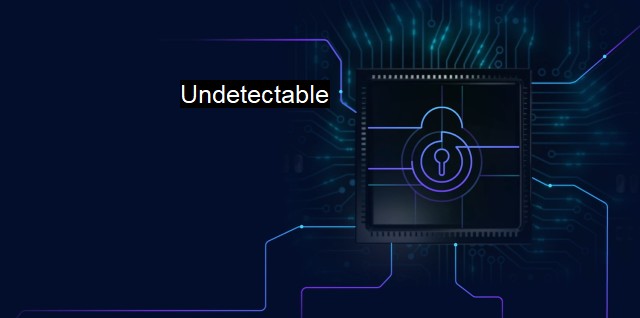What is Undetectable?
Exploring the Meaning of "Undetectable" in Cybersecurity and Antivirus Protection: An Overview of Threats, Detection Methods, and Prevention Strategies
The term "undetectable" is used to denote a situation where a malicious component or entity manages to infiltrate, take control, or operate within a system without being discovered by the protective mechanisms put into place, such as an antivirus or firewall. It refers to the ability of a virus, hacker, malware, or any criminal method to successfully elude and defy the protective measures enforced by the cybersecurity system.Understanding the concept of "undetectable" requires some background about the workings of a cybersecurity system. The primary role of systems such as antivirus programs is to detect and resolve any malicious activity in the system. They work by scanning for known threats based on predefined algorithms and virus databases that define the characteristics and behaviors of identified threats. Antivirus software can also detect potential threats by examining for abnormal behaviour or suspicious activities in the system. Therefore, when a wicked entity is referred to as undetectable, it implies a severe compromise of the system's security, meaning the entity is eluding current cybersecurity methodologies and threat hunting techniques.
The rise and evolution of undetectable threats pose a significant challenge to current cybersecurity frameworks. The continuous utilization of sophisticated techniques coupled with the rapid development of technology is complicating the contest between cybercriminals and older antivirus models. This growing sophistication has materialized into 'zero-day' threats, which are entirely new malware and attack methods that are unknown and undetected by traditional antivirus systems. The name refers to the fact that developers have zero days to identify and correct a vulnerability that is already exploited, making them a potent threat in cybersecurity.
'Polymorphic' and 'metamorphic' viruses add another ominous dimension to this arena of undetectable threats. Polymorphic viruses have the ability to change their code with each iteration, making them difficult for signature-based antivirus programs to detect. Metamorphic viruses take it a step further by not only altering their code but implementing a fluctuating encryption algorithm, making them even more elusive. Developers and coders must work diligently to devise detection methods to counter such malfeasance.
Advanced Persistent Threats (APTs) apply stealth techniques, designed to stay inactive or concealed within a system, thereby remaining 'undetectable' until they decide to activate. APTs are typically launched by highly skilled and funded groups intending to steal data or disrupt services over a long period.
It's noteworthy to mention that ‘Ransomware’ exploits can also remain undetectable until activated. They secretly encrypt files on a device and then demand a ransom from the user to decrypt them, providing extensive damage before their detection.
To impede these undetectable threats, cybersecurity professionals employ advanced techniques such as behavior-based detection, which looks for abnormal system behavior instead of matching signatures. Machine Learning and Artificial Intelligence are also critical elements of the advanced cybersecurity armour, with capacities to predict and promptly react to threats based on ongoing patterns.
The term "undetectable" pertaining to cybersecurity is resignifying and amplifying the arduous task of tackling cyber threats. The advent of such threats prompts impending necessity for heightened cybersecurity planning, bringing into focus the vitality of continuous adaptability, strategy redesigning, state-of-the-art technology application like AI and machine learning techniques, and niche specialists to continue ensuring a safer cyberspace.

Undetectable FAQs
What is an “undetectable” virus?
An “undetectable” virus is a malware program that is designed to evade detection by antivirus software. It is often developed by cybercriminals to bypass security measures and gain unauthorized access to a computer system.How does an “undetectable” virus work?
An “undetectable” virus uses various techniques to evade detection by antivirus software, such as encryption, polymorphism, and obfuscation. These techniques allow the virus to change its code structure and signature, making it difficult for antivirus software to recognize and block it.What are the risks of an “undetectable” virus?
An “undetectable” virus poses a significant threat to computer systems, as it can compromise sensitive data, steal personal information, and even damage the system itself. It can also give cybercriminals remote access to the system, allowing them to carry out further attacks or spread the infection to other devices.How can you protect your computer from “undetectable” viruses?
To protect your computer from “undetectable” viruses, you can follow some best practices such as keeping your antivirus software up-to-date, avoiding suspicious websites and emails, and regularly backing up your data. It is also recommended to use a reputable antivirus software that provides advanced features like behavioral analysis, machine learning, and real-time scanning to detect and block emerging threats.Related Topics
Malware detection Behavior-based detection Signature-based detection Zero-day threats Heuristic analysis
| | A | | | B | | | C | | | D | | | E | | | F | | | G | | | H | | | I | | | J | | | K | | | L | | | M | |
| | N | | | O | | | P | | | Q | | | R | | | S | | | T | | | U | | | V | | | W | | | X | | | Y | | | Z | |
| | 1 | | | 2 | | | 3 | | | 4 | | | 7 | | | 8 | | |||||||